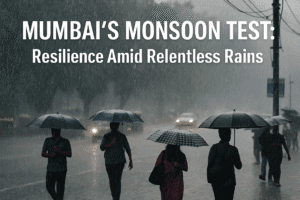Mumbai’s Monsoon Test: Resilience Amid Relentless Rains
Mumbai endured a relentless 97mm downpour in just 24 hours on July 27—ten days’ worth of average July rain—triggering widespread disruption. While temperatures cooled slightly to 25–29°C, high tide threats of up to 4.6 meters worsened flooding risks, especially in coastal areas like Worli and Cuffe Parade. Commuters faced severe delays on Central and Harbour lines, losing precious hours to waterlogged streets, while eastern suburbs struggled with chronic drainage issues.
In contrast, Pune saw gentler showers and no weather alerts, yet the Mumbai-Pune Expressway witnessed a tragic accident due to slippery conditions. The BMC urged citizens to avoid coastal roads during tide peaks and store clean water to counter post-rain contamination. Health warnings about mold risks in damp homes added another layer of concern.
Despite the setbacks, Mumbai’s spirit endured—with citizens and police stepping up as unofficial first responders. As the skies clear, the real test begins: repairing broken systems before the next monsoon lash.

Mumbai’s Monsoon Test: Resilience Amid Relentless Rains
(Based on weather patterns as of July 27, 2025)
The Deluge in Numbers
- 24-Hour Soaking: 97mm rainfall recorded citywide – equivalent to 10 days of average July rain in just one day.
- Temperature Relief: Steady 25–29°C range offering slight respite from typical Mumbai humidity.
- High Tide Alert: Sunday’s 4.6-meter tide (13:56 hrs) threatens coastal flooding, with another 4m+ surge expected overnight.
Human Impact Beyond Headlines
While weather warnings dominate coverage, three underreported struggles define Mumbai’s rainy reality:
- The Commuter’s Gamble: Central Railway delays (10–12 mins) and Harbour Line holdups (7–8 mins) compound rush-hour chaos. The real cost? Workers losing 2+ daily hours navigating waterlogged streets.
- Coastal Community Alert: Fishing communities along Cuffe Parade and Worli face dual threats of tidal surges and gusty winds (40kmph). BMC’s advice: “Avoid shorelines during high tide windows.”
- Infrastructure Strain: Eastern suburbs bore the brunt (48mm rainfall), exposing chronic drainage issues despite civic claims.
Pune’s Paradox
Just 150km away, Pune experiences a divergent monsoon:
- Gentler Showers: 13mm rainfall (1/7th of Mumbai’s volume)
- No Alerts Issued: Stable 22–26°C temperatures with light rain expected through week’s end
- Tragic Contrast: Yesterday’s Mumbai-Pune Expressway accident (1 dead, 18 injured) underscores heightened road risks during downpours.
The Silver Lining Forecast
Next 72 Hours Outlook
| Date | Mumbai Outlook | Pune Outlook |
| July 27 | Orange Alert ☔️ Heavy rains | 🌧️ Moderate rain |
| July 28 | ⛅ Cloudy + Moderate showers | 🌦️ Light rain |
| July 29 | 🌦️ Isolated drizzles | 🌤️ Partly cloudy |
Expert Insights for Residents
- Travel Smart: Use BMC’s tide timetable (avoid coastal roads 13:00–14:30 & 01:00–02:30)
- Flood Prep: Store drinking water – historical data shows pipeline contamination spikes post-100mm rainfall
- Health Check: Monitor humidity-induced mold in homes (ideal growth range: 25–30°C)
Why This Matters
Mumbai’s rainfall isn’t just weather – it’s a stress test for urban resilience. The 300mm cumulative rain this week exposed how localized flooding cripples economic activity. Yet the city’s spirit persists: Police teams worked 18-hour shifts clearing key corridors, while communities revived neighborhood rain helpdesks – unofficial networks sharing real-time flood updates when official systems lag.
As rains ease post-Tuesday, the true challenge begins: fixing broken drains before the next downpour. For now, the umbrella remains Mumbai’s most vital accessory.
You must be logged in to post a comment.